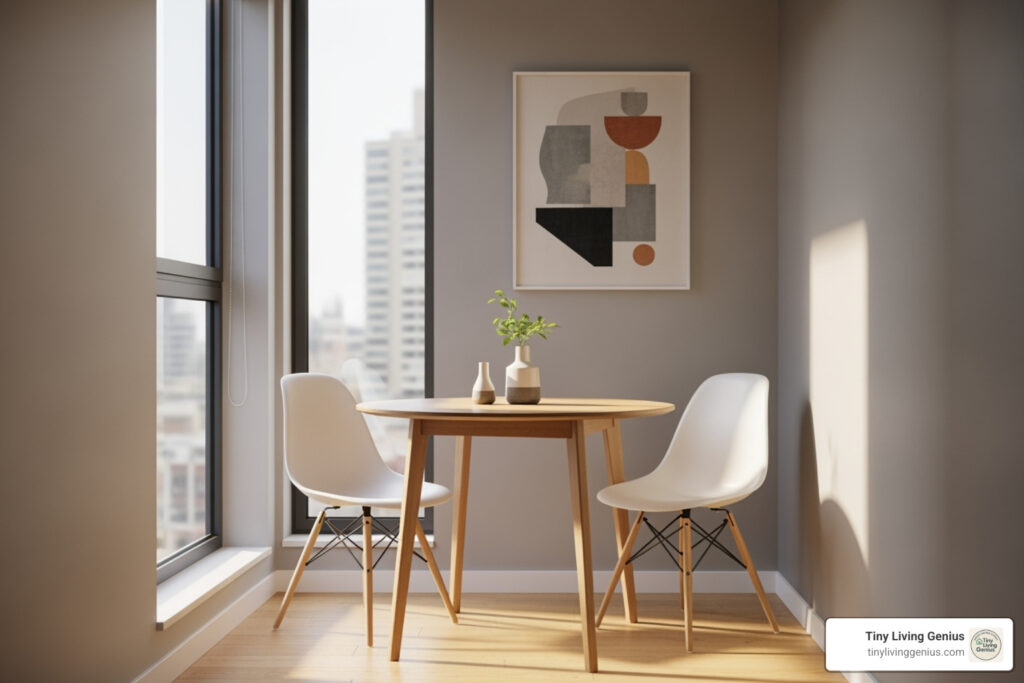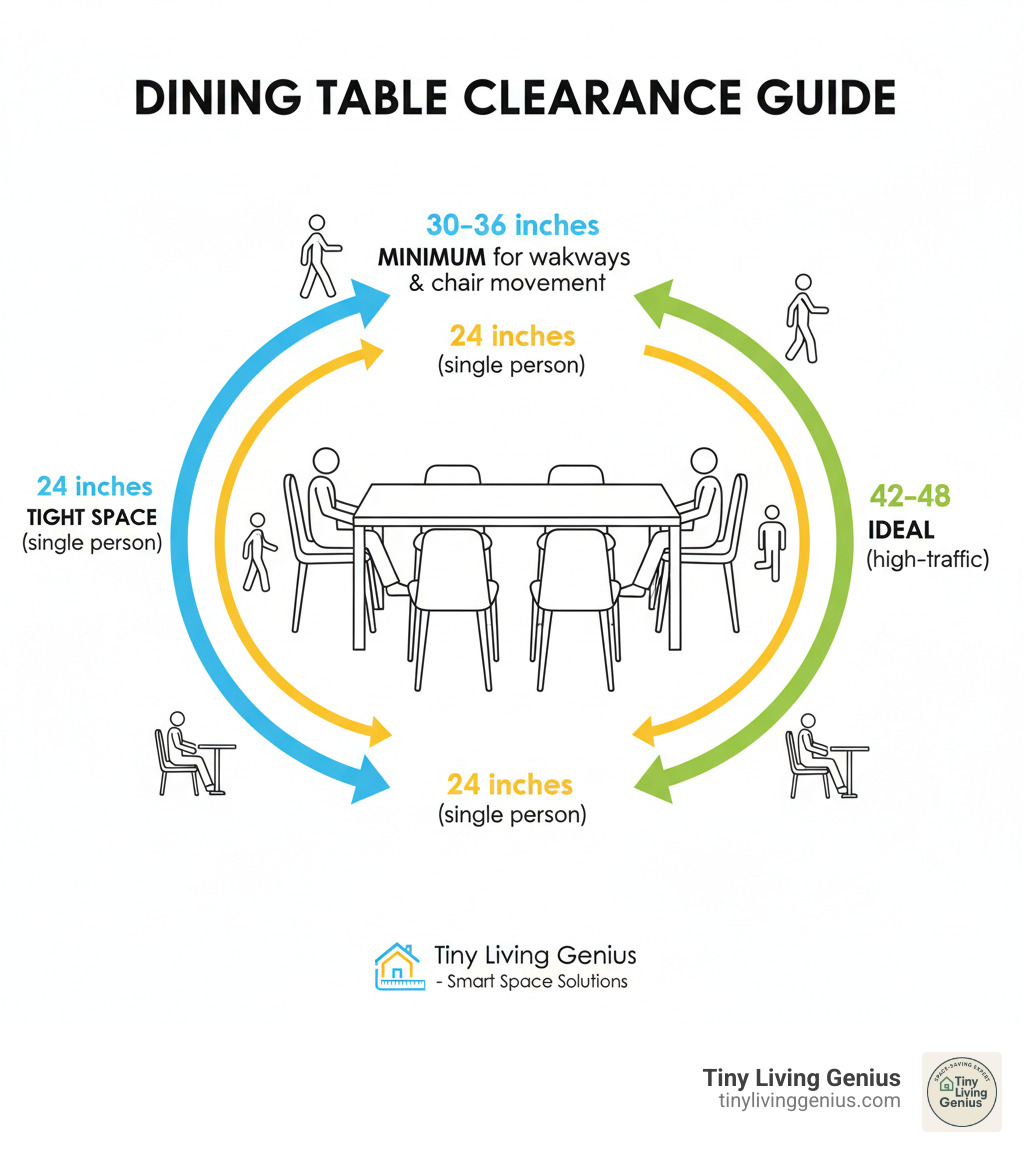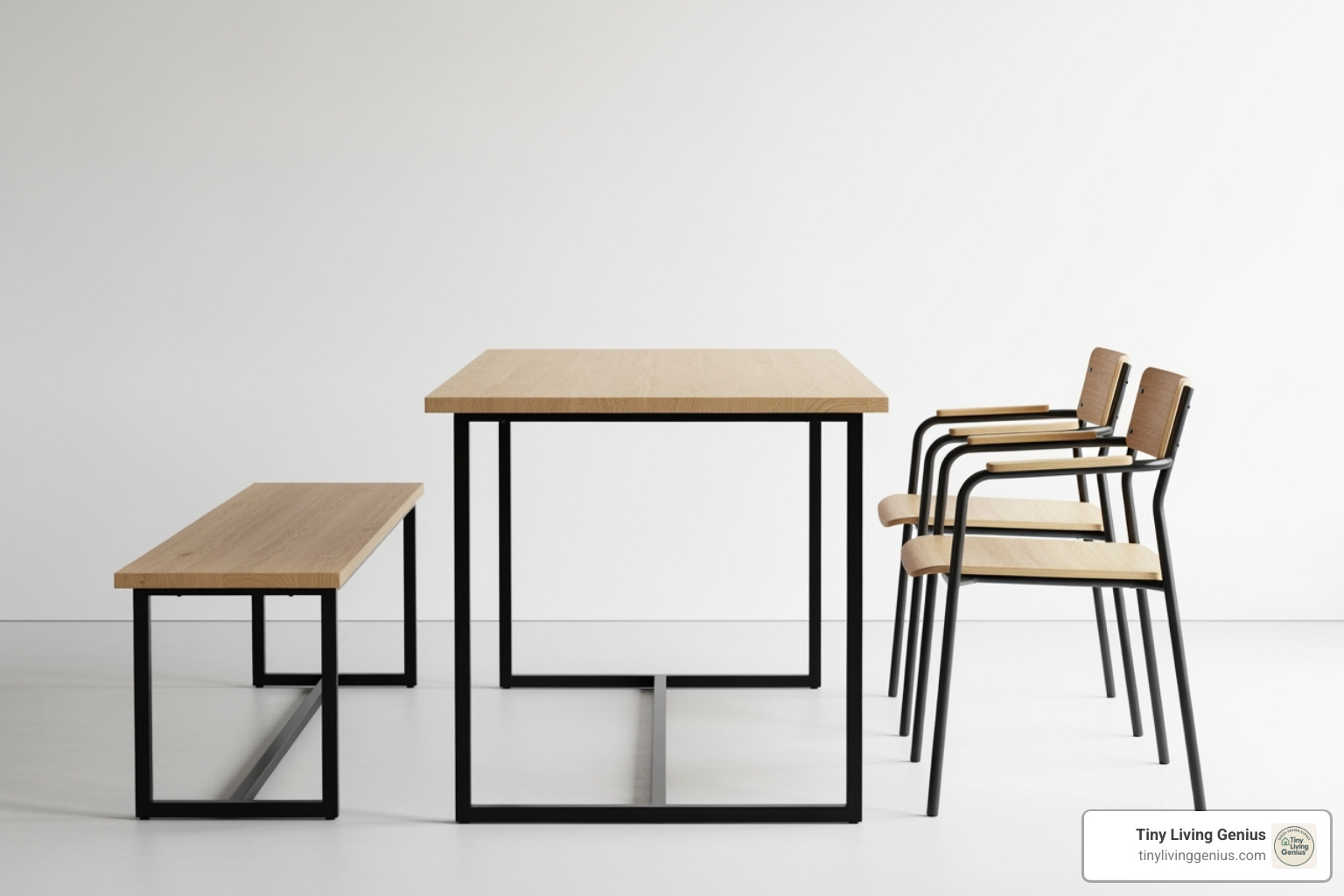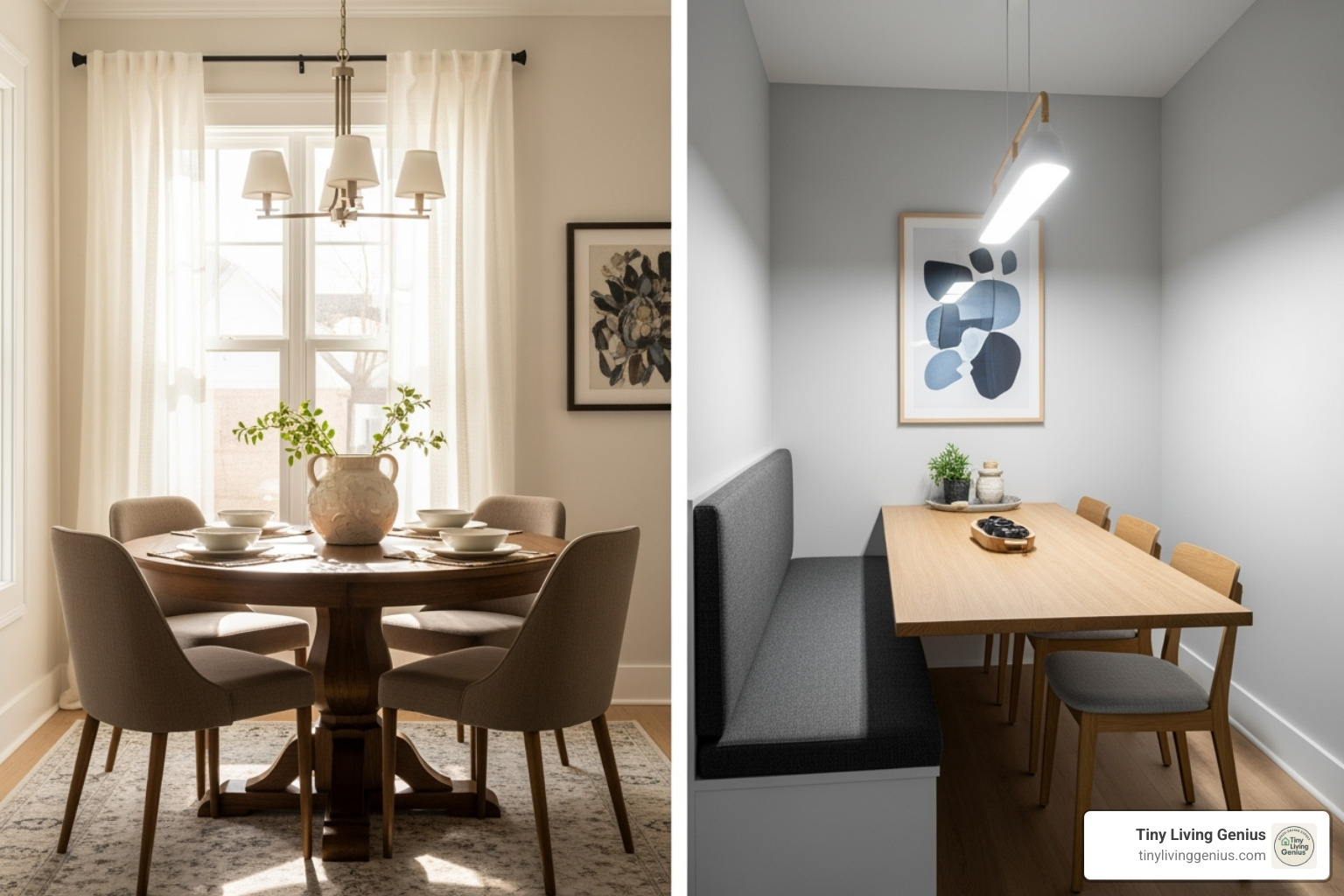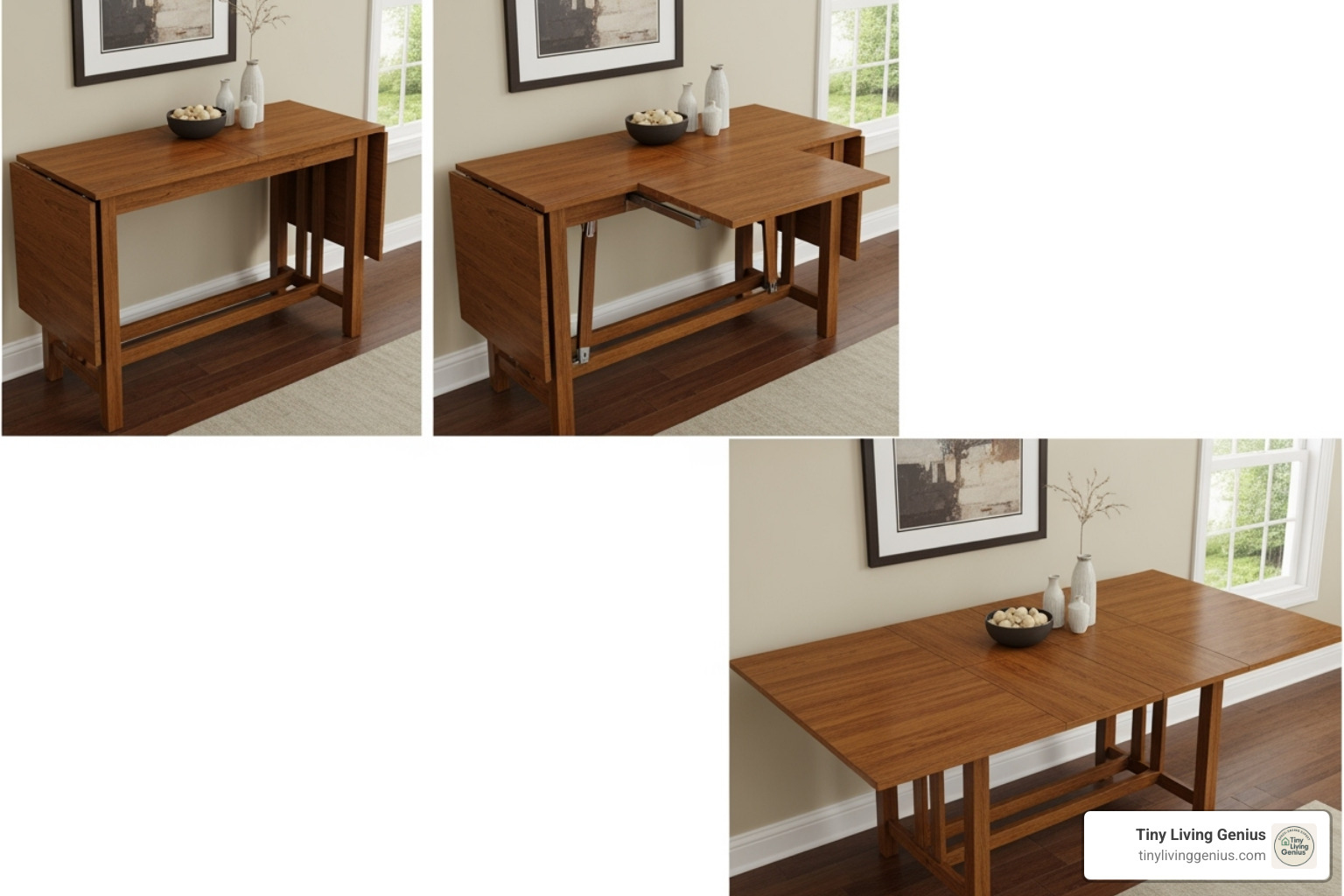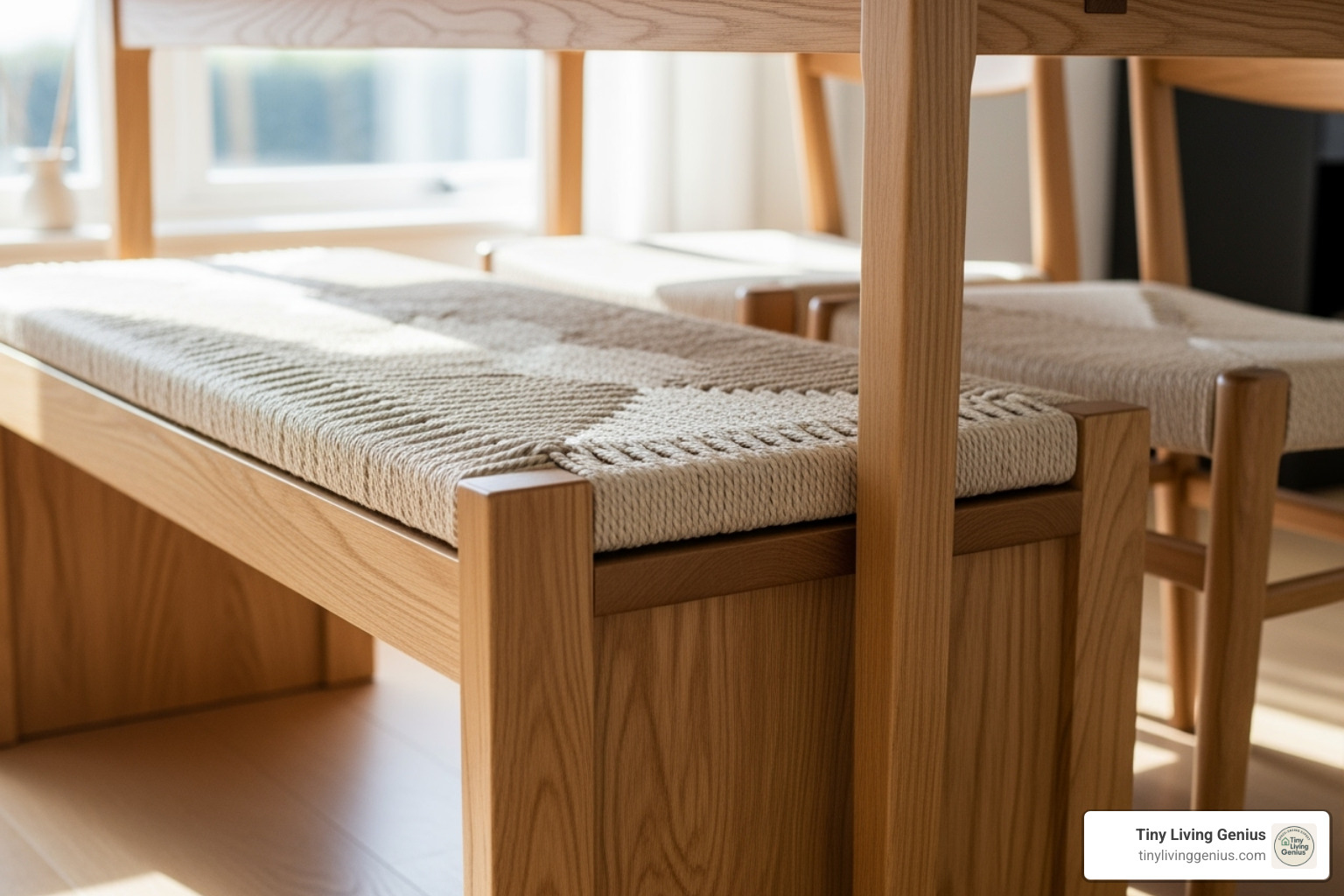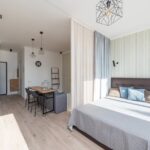Dining Room Tables for Narrow Spaces: 3 Smart Buys
Why Narrow Dining Spaces Don’t Mean Sacrificing Style or Function
Finding the right dining room table for a narrow space can transform a cramped corner into a functional, inviting place to share meals without overwhelming your limited square footage.
Top solutions for narrow dining spaces:
- Round tables (36″+ diameter) – Best for square or corner areas; easier to steer around
- Rectangular tables (28-30″ wide x 72-80″ long) – Ideal for long, narrow rooms; can seat 4-6 people
- Drop-leaf or extendable tables – Fold down when not in use; expand for guests
- Pedestal base designs – More legroom and flexibility for chair placement
- Light-colored or glass-top tables – Create an airy, open feel in tight spaces
Key measurement: Allow at least 30-36 inches of clearance around your table for comfortable movement and chair pull-back.
A narrow dining space is a common challenge. For most homes, a 4-seater dining table hits the sweet spot—big enough to gather around, but compact enough to fit. The shape matters: round tables soften a room and are easy to steer, while rectangular tables maximize length in long, narrow rooms and can often double as a desk.
Space-saving tables and chairs are vital for maintaining a room’s flow. Furniture with a narrow profile prevents a cramped feeling. With the right shape, height, and features like drop leaves, you can create a cozy setting that works for daily meals and occasional guests.
I’m Ramy Saber, a Civil Engineer and founder of Tiny Living Genius, where I’ve spent years researching and testing practical solutions for compact living, including the best dining room tables for narrow spaces. My goal is to help you find furniture that maximizes both functionality and style, no matter how tight your dining area may be.
Before You Buy: Measuring and Planning for Success
Finding the perfect dining room table for narrow spaces requires smart planning before you click “buy now.” Too often, a new table arrives and turns the dining area into an obstacle course. It might fit, but with no room to pull out a chair, it’s not functional. Proper planning ensures your dining setup looks great and works seamlessly.
The biggest mistake is underestimating the importance of clearance space. You need room for people to pull out chairs and walk around the table. This is what makes a dining area functional.
The golden rule is to aim for at least 30-36 inches of clearance around your table. This allows enough room to move around without an awkward shuffle. In very tight, low-traffic areas, you might manage with 24 inches, but it will feel cramped. For high-traffic zones, 42-48 inches is ideal.
Before browsing, grab a measuring tape. Measure your dining area’s length and width, and account for obstacles like radiators, shelves, or inward-swinging doors that will affect table placement.
A great trick for visualizing the fit is the “masking tape trick.” Use painter’s tape to outline the table’s dimensions on your floor. Walk around it and pull out a chair to see how it feels. For a 3D preview, stack cardboard boxes to the table’s height. This helps you spot potential problems—like a blocked path to the kitchen—before you make the purchase.
The goal is to maintain good flow. A well-chosen dining room table for narrow spaces should make daily movements easier. For more guidance, check out our comprehensive guide: How to Choose the Right Furniture for Your Small Space: A Comprehensive Guide.
Here’s a quick reference for the clearance measurements you’ll need:
| Clearance Type | Minimum Required (inches) | Ideal (inches) | Notes |
|---|---|---|---|
| Clearance around table (minimal) | 24 (round) – 30 (rectangular) | 36-48 (round) – 48-60 (rectangular) | Allows for walking around and pulling out chairs. |
| Passage (room periphery) | 36 | 48-60 (around a centered 42″ round table, 7×7 room) | Clear path for movement, especially in high-traffic areas. |
| Seated diner pushing back chair | 24-30 | 30-36 | Space needed for a person to comfortably sit and push their chair back from the table. |
| Walkway behind seated diner | 12-18 | 18-24 | Additional space behind a seated diner for someone to walk past. |
The Best Dining Room Tables for Narrow Spaces
Finding the perfect dining room table for a narrow space doesn’t mean sacrificing style or comfort. With the right solutions, you can have both function and design, even with limited square footage.
Our experience shows a 4-seater dining table is the sweet spot for most narrow areas. It’s large enough for daily use but won’t overwhelm the room. The key is a narrow profile, with tables up to 30 inches deep that fit without causing a cramped feeling. For an extensive selection of narrow dining options, check out Modern Narrow (Up to 30″ Depth) Dining Tables at AllModern. In a small space, your dining table must be more than just a place to eat. Multifunctional tables are essential. A rectangular table can double as a desk, craft station, or extra kitchen prep space, ensuring every piece of furniture earns its keep. For curated inspiration and buyer tips, explore our Space-Saving Furniture guides.
Round vs. Rectangular: Which Shape is Right for You?
Should you choose a round or rectangular dining room table for a narrow space? The answer depends on your room’s shape.
Round tables soften a room’s look and are easier to steer, with no sharp corners to bump into. A 36-inch round table seats four and can be pushed against a wall for two. They promote conversation and are ideal for square-ish rooms or breakfast nooks.
For long, narrow dining areas, rectangular tables are often the best choice as they complement the room’s shape. A table that’s 28-30 inches wide and 72-80 inches long can seat up to six. They are also excellent for dual-purpose use as a desk or workspace.
For any shape, consider a pedestal base. It offers more flexibility for chair placement and better legroom than traditional four-legged tables—a huge advantage in tight spaces.
Smart Designs: Drop-Leaf and Extendable Tables
The secret weapon for narrow dining spaces is a table that can change size. Drop-leaf and extendable tables are lifesavers when you need flexibility without sacrificing square footage.
Drop-leaf tables feature hinged leaves that fold down, changing a dining table into a slim console or a two-seater. This fold-away design is perfect for reclaiming floor space in daily life. When guests arrive, simply lift the leaves. Some models even include built-in storage.
Extendable tables offer similar flexibility using removable leaves, such as butterfly leaf or gateleg mechanisms, to increase length. Keep them compact for daily use and expand for hosting. This flexibility for guests means you can have a table that fits your space and still entertain.
Materials and Finishes That Create Space
The material and finish of your dining room table for a narrow space are as important as its size. It’s about how the table feels in the room, not just its physical dimensions.
Glass tops create an airy look by allowing light and sightlines to pass through, making a space feel more open. Paired with a sleek pedestal base or slim metal bases, a glass table can seem to float in the room.
Alternatively, light wood finishes and white tables reflect light, keeping the space feeling open and bright. Pale woods like birch or ash, or crisp white finishes, blend with the decor rather than creating a heavy focal point that shrinks the room.
Streamlined design works with any style, from modern to rustic. Tables with clean lines and lighter materials will always make a space feel more open. The goal is to integrate the table naturally into your room, not make it an obstacle. Choose materials that improve the space, and your narrow dining area will feel more generous.
Maximizing Your Seating and Style
Once you’ve found the perfect dining room table for a narrow space, the next step is making it both functional and beautiful. The goal is to create an inviting dining area with comfortable seating and easy movement.
The right seating can make or break a narrow dining area. A bulky chair can create an obstacle course, while a smart choice can seat more people and keep the room feeling spacious. Seating and styling work together to define the feel of your space. For more ideas, see our guide on Creative Ideas for Small Space Furniture: Maximizing Functionality in Small Space.
Choosing the Right Chairs for Narrow Dining Room Tables
Your chair selection is as critical as your table. The wrong chairs—too wide, too bulky, or unable to tuck away—can render a narrow table impractical.
- Armless chairs are a top choice. They slide further under the table, saving walking space and creating a less cluttered look.
- Benches are a space-saving superpower, especially against a wall. They seat more people than chairs and slide completely under the table after meals.
- Stools, especially backless ones, offer maximum tuckability. They can disappear under the table, clearing floor space, and work well with counter-height tables.
- Low-back chairs provide support without creating a visual barrier, making the room feel more open.
- Transparent chairs (acrylic or polycarbonate) provide seating with almost no visual weight, creating a remarkably spacious feel.
- Stackable chairs are a practical solution for occasional guests. Store them in a closet and bring them out as needed.
The golden rule: Choose chairs that tuck completely under the table to keep pathways clear and functional.
Styling Tricks to Make Your Narrow Dining Area Feel Bigger
With the right furniture in place, styling can make your dining area feel inviting and roomy. For additional small-space dining inspiration, browse Pottery Barn’s Small Space Dining Solutions.
- Mirrors: A large mirror on an adjacent wall is a powerful trick. It bounces light and creates an illusion of depth, making a narrow space feel much larger.
- Lighting: Pay attention to lighting. Avoid heavy, low-hanging pendants. Opt for recessed lighting, sleek wall sconces, or a streamlined chandelier to provide ample light without visual bulk.
- Table Linens: On a narrow table, skip the table runner, as it can emphasize the table’s slimness. Use placemats instead to add color and texture without clutter.
- Centerpieces: For centerpieces, think vertically. A vase with tall flowers or slender candles draws the eye upward without taking up precious surface area. On a narrow table, minimalist is best.
- Color Palette: Accept a light color palette. Whites, soft grays, and pastels reflect light and create an airy feeling. You can add pops of color, but a light base makes a huge difference.
These practical strategies can transform your dining area. For more inspiration, explore more small-space dining ideas in our Space-Saving Furniture collection.
Frequently Asked Questions about Dining Tables for Narrow Spaces
Navigating small-space furniture raises many questions. Here are our practical answers to the most common questions about dining room tables for narrow spaces.
How much space do you need around a dining table?
As a general rule, aim for a minimum of 30-36 inches of clearance around your table. This allows room for people to walk by and pull out chairs. In very tight, low-traffic areas, you might manage with 24 inches, but it will feel cramped. For high-traffic zones, 42-48 inches is ideal for a comfortable flow.
Can a round table work in a narrow room?
Yes. While rectangular tables are a common choice for long rooms, a smaller round table can be a smart solution. A 36-inch diameter round table can be placed in a corner or against a wall to create a cozy nook. Its curved edges improve flow by eliminating sharp corners, which is a major benefit in tight spaces. Round tables also foster a more intimate, conversational atmosphere.
What is the best way to add seating for guests with a narrow table?
The best solutions involve flexible furniture:
- Extendable or drop-leaf tables: These are our top recommendation. They expand to accommodate guests and shrink for daily use, saving valuable floor space.
- Dining benches: A bench can seat more people than chairs in the same footprint, especially when placed against a wall. It can also be tucked completely under the table.
- Stackable seating: Keep stackable stools or armless chairs in a closet. Bring them out for guests and store them away afterward to keep your space clear.
Conclusion: Dine in Style, No Matter the Size
Finding the perfect dining room table for a narrow space is about making smart, intentional choices. As we’ve shown, a compact dining area can be an opportunity for creative design, not a limitation.
By prioritizing key principles—measuring for clearance, choosing the right shape and materials, and opting for flexible furniture like drop-leaf tables and space-saving chairs—you can transform any tight corner into a stylish and functional dining spot. In a small home, every piece must be versatile. A well-chosen narrow dining table can serve as a workspace, a craft area, and a gathering spot, making it one of the most valuable pieces of furniture you own.
Style and practicality go hand-in-hand. A sleek glass-top table, a charming drop-leaf design, or a minimalist bench can all improve your home’s flow and aesthetic. We hope this guide has empowered you to create a dining area you love, no matter the size.
Ready to find more ways to make your compact home work beautifully? Explore our complete guide to Space-Saving Furniture for innovative ideas that will help you maximize every square foot.

